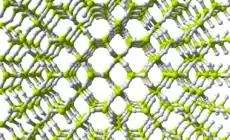Plutonium hydride
Plutonium hydride is a non-stoichiometric chemical compound with the formula PuH2+x. It is one of two characterised hydrides of plutonium, the other is PuH3.[1] PuH2 is non-stoichiometric with a composition range of PuH2 – PuH2.7. Additionally metastable stoichiometries with an excess of hydrogen (PuH2.7 – PuH3) can be formed.[1] PuH2 has a cubic structure. It is readily formed from the elements at 1 atmosphere at 100–200 °C:[1] When the stoichiometry is close to PuH2 it has a silver appearance, but gets blacker as the hydrogen content increases, additionally the color change is associated with a reduction in conductivity.[2]
- Pu + H2 → PuH2
| Names | |
|---|---|
| IUPAC name
Plutonium dihydride (excess hydrogen) | |
| Systematic IUPAC name
Plutonium(2+) hydride | |
| Other names
Plutonium dihydride Plutonium(II) hydride | |
| Identifiers | |
3D model (JSmol) |
|
| ChemSpider | |
PubChem CID |
|
CompTox Dashboard (EPA) |
|
| |
| |
| Properties | |
| H2Pu | |
| Molar mass | 246 g·mol−1 |
| Appearance | Black, opaque crystals |
Except where otherwise noted, data are given for materials in their standard state (at 25 °C [77 °F], 100 kPa). | |
| Infobox references | |
Studies of the reaction of plutonium metal with moist air at 200–350 °C showed the presence of cubic plutonium hydride on the surface along with Pu2O3, PuO2 and a higher oxide identified by X-ray diffraction and X-ray photoelectron spectroscopy as the mixed-valence phase PuIV3−xPuVIxO6+x.[3] Investigation of the reaction performed without heating suggests that the reaction of Pu metal and moist air the production of PuO2 and a higher oxide along with adsorbed hydrogen, which catalytically combines with O2 to form water.[4]
Plutonium dihydride on the surface of hydrided plutonium acts as a catalyst for the oxidation of the metal with consumption of both O2 and N2 from air.[5]
See also
References
- Gerd Meyer, 1991, Synthesis of Lanthanide and Actinide Compounds Springer, ISBN 0-7923-1018-7.
- The Chemistry of the Actinide and Transactinide Elements, Lester R. Morss, Norman M. Edelstein, J. Fuger, Springer, 2010, ISBN 9789048131464
- J. L. Stakebake, D. T. Larson, J. M. Haschke: Characterization of the Plutonium-water Reaction II: Formation of a Binary Oxide containing Pu(VI), Journal of Alloys and Compounds, 202, 1–2, 1993, 251–263, doi:10.1016/0925-8388(93)90547-Z.
- J. M. Haschke, T. H. Allen, L. A. Morales: Surface and Corrosion Chemistry of Plutonium, Los Alamos Science, 2000, 252.
- John M. Haschke Thomas H. Allen: Plutonium Hydride, Sesquioxide and Monoxide Monohydride: Pyrophoricity and Catalysis of Plutonium Corrosion, Journal of Alloys and Compounds, 320, 1, 2001, 58–71, doi:10.1016/S0925-8388(01)00932-X.






